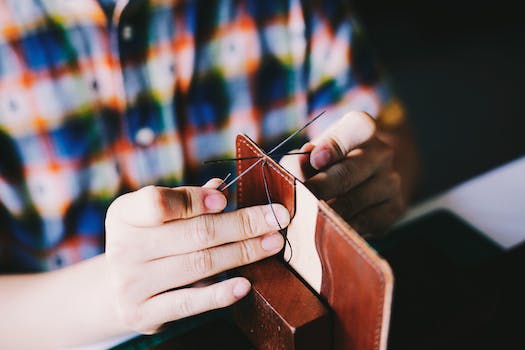How To Start A Business Making Shirts
“From design to profit: A beginner’s guide to launching a successful shirt-making business.”
Introduction
Starting a business making shirts can be a great way to turn your passion for fashion into a profitable venture. Whether you’re interested in creating custom designs or selling pre-made shirts, there are a few key steps you’ll need to take to get started. In this article, we’ll walk you through the process of starting a shirt-making business, from developing your brand to sourcing materials and marketing your products.
Finding Your Niche in the Shirt-Making Industry
Starting a business making shirts can be a great way to turn your passion for fashion into a profitable venture. However, with so many players in the market, it can be challenging to find your niche. In this article, we will explore some tips on how to find your niche in the shirt-making industry.
The first step in finding your niche is to identify your target market. Who are the people you want to sell your shirts to? Are they men, women, or children? What is their age range? What is their style preference? Answering these questions will help you create a clear picture of your ideal customer.
Once you have identified your target market, the next step is to research the market. Look at what your competitors are doing and identify gaps in the market. For example, if your target market is women aged 25-35 who prefer sustainable fashion, you may find that there are not many sustainable shirt options available in the market. This could be an opportunity for you to create a sustainable shirt line that caters to this market.
Another way to find your niche is to focus on a specific style or design. For example, you could specialize in creating vintage-inspired shirts or shirts with unique prints. This will help you stand out in the market and attract customers who are looking for something different.
It is also important to consider the quality of your shirts. Customers are willing to pay more for high-quality shirts that last longer. Therefore, investing in high-quality materials and ensuring that your shirts are well-made can help you attract customers who value quality.
In addition to focusing on your target market and design, you should also consider your brand identity. What do you want your brand to represent? Is it a fun and playful brand or a sophisticated and elegant brand? Your brand identity should be reflected in your shirt designs, packaging, and marketing materials.
Once you have identified your niche, it is important to test your product in the market. You can start by creating a small batch of shirts and selling them at local markets or online. This will help you get feedback from customers and refine your product before investing in a larger production run.
In conclusion, finding your niche in the shirt-making industry requires a combination of research, creativity, and testing. By identifying your target market, researching the market, focusing on a specific style or design, investing in quality, and developing a strong brand identity, you can create a successful shirt-making business. Remember to stay true to your vision and passion for fashion, and you will be on your way to creating a profitable and fulfilling business.
Creating a Business Plan for Your Shirt-Making Business

Starting a business can be a daunting task, but with the right plan in place, it can be a rewarding and profitable venture. If you’re interested in starting a business making shirts, the first step is to create a business plan. A business plan is a roadmap that outlines your goals, strategies, and financial projections for your business. In this article, we’ll discuss the key components of a business plan for a shirt-making business.
Executive Summary
The executive summary is the first section of your business plan and should provide an overview of your business. It should include a brief description of your business, your target market, your products, and your goals. This section should be concise and compelling, as it will be the first thing potential investors or lenders will read.
Market Analysis
The market analysis section of your business plan should provide an in-depth analysis of your target market. This section should include information on the size of your market, your competition, and your target customers. You should also include information on the trends and opportunities in the shirt-making industry.
Products and Services
In this section, you should provide a detailed description of your products and services. This should include information on the types of shirts you will be making, the materials you will use, and any customization options you will offer. You should also include information on your pricing strategy and how you will differentiate your products from your competitors.
Marketing and Sales
The marketing and sales section of your business plan should outline your strategies for promoting and selling your products. This should include information on your target customers, your advertising and promotional strategies, and your sales channels. You should also include information on your pricing strategy and how you will measure the success of your marketing efforts.
Operations
The operations section of your business plan should provide an overview of how your business will operate. This should include information on your production process, your suppliers, and your distribution channels. You should also include information on your staffing needs and any equipment or technology you will need to operate your business.
Financial Projections
The financial projections section of your business plan should provide an overview of your expected revenue and expenses. This should include information on your startup costs, your monthly expenses, and your projected revenue. You should also include information on your break-even point and your expected return on investment.
Conclusion
Creating a business plan is an essential step in starting a shirt-making business. It will help you to identify your target market, develop your products and services, and create a roadmap for your business. By following the key components outlined in this article, you can create a comprehensive and compelling business plan that will help you to achieve your goals and succeed in the shirt-making industry.
Sourcing Materials and Equipment for Shirt-Making
Starting a business making shirts can be a fun and rewarding venture. However, before you can start producing shirts, you need to source the necessary materials and equipment. In this article, we will discuss the steps you need to take to source the materials and equipment needed to start your shirt-making business.
The first step in sourcing materials for shirt-making is to determine the type of fabric you want to use. There are many different types of fabrics available, including cotton, polyester, silk, and linen. Each fabric has its own unique properties, so it’s important to choose the right one for your shirts. Consider factors such as durability, comfort, and cost when selecting your fabric.
Once you have chosen your fabric, you will need to find a supplier. There are many fabric suppliers available, both online and offline. Look for a supplier that offers high-quality fabrics at a reasonable price. You may also want to consider a supplier that offers a wide range of fabrics, so you can experiment with different materials and designs.
In addition to fabric, you will also need to source other materials such as thread, buttons, and zippers. These materials can be found at most fabric stores or online. Look for high-quality materials that will withstand the wear and tear of daily use.
Once you have sourced your materials, you will need to invest in equipment to start producing your shirts. The most important piece of equipment you will need is a sewing machine. There are many different types of sewing machines available, so it’s important to choose one that is suitable for your needs. Look for a machine that is easy to use and can handle a variety of fabrics.
In addition to a sewing machine, you will also need other equipment such as scissors, measuring tape, and a cutting mat. These tools are essential for cutting and measuring fabric accurately. You may also want to invest in a serger, which is a specialized sewing machine that can create finished edges on fabric.
When sourcing equipment, it’s important to consider your budget. Sewing machines and other equipment can be expensive, so it’s important to choose equipment that is within your budget. You may also want to consider purchasing used equipment, which can be a cost-effective option.
In addition to sourcing materials and equipment, you will also need to consider the space where you will be producing your shirts. You will need a dedicated workspace that is well-lit and ventilated. You may also want to invest in storage solutions such as shelves or cabinets to keep your materials and equipment organized.
In conclusion, sourcing materials and equipment is an important step in starting a business making shirts. Take the time to research suppliers and equipment options to ensure that you are getting high-quality materials and equipment that are within your budget. With the right materials and equipment, you can start producing high-quality shirts that will delight your customers.
Designing and Printing Your Shirts
Starting a business making shirts can be a fun and rewarding venture. However, before you can start selling your shirts, you need to design and print them. Here are some tips on how to design and print your shirts.
First, you need to come up with a design for your shirt. This can be a logo, a slogan, or a graphic. You can create your design using a graphic design software like Adobe Illustrator or Canva. If you are not comfortable with designing, you can hire a freelance graphic designer to create a design for you.
Once you have your design, you need to decide on the type of printing method you want to use. There are several printing methods available, including screen printing, heat transfer, and direct-to-garment printing. Each method has its pros and cons, so it’s important to choose the one that best suits your needs.
Screen printing is the most popular printing method for shirts. It involves creating a stencil of your design and then using a squeegee to push ink through the stencil onto the shirt. Screen printing is best for large orders and designs with few colors.
Heat transfer printing involves printing your design onto transfer paper and then using a heat press to transfer the design onto the shirt. Heat transfer printing is best for small orders and designs with many colors.
Direct-to-garment printing involves printing your design directly onto the shirt using a specialized printer. Direct-to-garment printing is best for small orders and designs with many colors.
Once you have chosen your printing method, you need to choose the type of shirt you want to print on. There are several types of shirts available, including cotton, polyester, and blends. Each type of shirt has its pros and cons, so it’s important to choose the one that best suits your needs.
Cotton shirts are the most popular type of shirt for printing. They are comfortable, durable, and absorbent. Polyester shirts are lightweight, breathable, and moisture-wicking. Blended shirts are a combination of cotton and polyester and offer the benefits of both materials.
After you have chosen your shirt, you need to prepare it for printing. This involves pre-treating the shirt to ensure that the ink adheres properly. Pre-treatment involves applying a special solution to the shirt and then drying it.
Once your shirt is pre-treated, you can start printing. If you are using screen printing, you will need to set up your screen and stencil. If you are using heat transfer printing, you will need to print your design onto transfer paper and then use a heat press to transfer the design onto the shirt. If you are using direct-to-garment printing, you will need to load your shirt into the printer and then print your design directly onto the shirt.
After you have printed your shirts, you need to cure the ink. Curing involves applying heat to the ink to ensure that it sets properly. Curing times and temperatures vary depending on the type of ink and printing method you are using.
In conclusion, designing and printing your shirts is an important part of starting a business making shirts. By following these tips, you can create high-quality shirts that will impress your customers. Remember to choose the right printing method, shirt type, and pre-treatment process for your needs. With a little practice and patience, you can create shirts that people will love to wear.
Marketing and Selling Your Shirts to Your Target Audience
Starting a business making shirts can be a fun and rewarding venture. However, once you have created your designs and produced your shirts, the next step is to market and sell them to your target audience. Here are some tips on how to effectively market and sell your shirts.
1. Identify your target audience
Before you start marketing and selling your shirts, it is important to identify your target audience. Who are the people that would be interested in your designs? Are they male or female? What age group do they belong to? What are their interests and hobbies? Once you have identified your target audience, you can tailor your marketing efforts to reach them.
2. Create a brand identity
Creating a brand identity is crucial in marketing and selling your shirts. Your brand identity should reflect your designs and appeal to your target audience. This includes your logo, website, social media presence, and packaging. Make sure that your brand identity is consistent across all platforms.
3. Utilize social media
Social media is a powerful tool in marketing and selling your shirts. Create social media accounts for your business and post regularly. Use hashtags to reach a wider audience and engage with your followers. You can also collaborate with influencers in your niche to promote your shirts.
4. Attend events
Attending events such as trade shows, pop-up shops, and markets can help you reach a wider audience. This is a great opportunity to showcase your designs and interact with potential customers. Make sure to have business cards and promotional materials on hand.
5. Offer promotions and discounts
Offering promotions and discounts can entice customers to purchase your shirts. This can include free shipping, buy one get one free, or a percentage off their purchase. Make sure to promote your promotions on social media and your website.
6. Provide excellent customer service
Providing excellent customer service is crucial in retaining customers and building a loyal following. Respond promptly to customer inquiries and concerns. Make sure to package and ship your shirts in a timely manner. Consider including a handwritten note or small gift with each purchase to show your appreciation.
7. Collect customer feedback
Collecting customer feedback can help you improve your designs and customer experience. Consider sending out surveys or asking for feedback on social media. Use this feedback to make improvements and better serve your customers.
In conclusion, marketing and selling your shirts to your target audience requires a combination of strategy, creativity, and excellent customer service. By identifying your target audience, creating a brand identity, utilizing social media, attending events, offering promotions and discounts, providing excellent customer service, and collecting customer feedback, you can effectively market and sell your shirts and build a successful business.
Conclusion
Starting a business making shirts requires careful planning and execution. It is important to research the market, identify your target audience, and create a unique brand identity. Additionally, you will need to consider factors such as production costs, pricing, and distribution channels. By following these steps and staying committed to your vision, you can successfully launch and grow a profitable shirt-making business.






